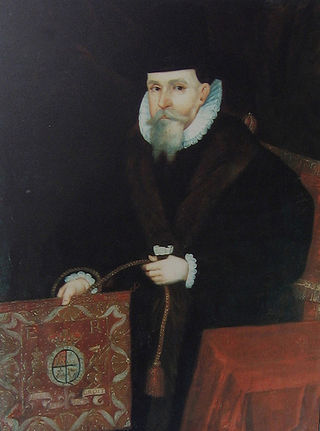Related Research Articles

Richard Boyle, 1st Earl of Burlington, 2nd Earl of Cork was an Anglo-Irish nobleman who served as Lord High Treasurer of Ireland and was a Cavalier.

Adam Loftus was Archbishop of Armagh, and later Dublin, and Lord Chancellor of Ireland from 1581. He was also the first Provost of Trinity College Dublin.

Sir John Norris, or Norreys, of Rycote, Oxfordshire, and of Yattendon and Notley in Berkshire, was an English soldier. The son of Henry Norris, 1st Baron Norreys, he was a lifelong friend of Queen Elizabeth.

The Battle of Curlew Pass was fought on 15 August 1599 during the campaign of the Earl of Essex in the Nine Years' War, between an English force under Sir Conyers Clifford and a rebel Irish force led by Aodh Ruadh Ó Domhnaill. The English were ambushed and routed while marching through a pass in the Curlew Mountains, near the town of Boyle, in the west of Ireland. The English forces suffered heavy casualties. Losses by allied Irish forces were not recorded but were probably minimal.

Sir Richard Bingham was an English soldier and naval commander. He served under Queen Elizabeth I during the Tudor conquest of Ireland and was appointed governor of Connacht.
Sir Anthony Kingston was an English royal official, holder of various positions under several Tudor monarchs.
William Harbord, of Grafton Park, was an English diplomat and politician who sat in the House of Commons at various times between 1661 and 1690.
Maurice Fitzmaurice FitzGerald I, 2nd Lord of Offaly was a Norman in Ireland peer, soldier, and Justiciar of Ireland from 1232 to 1245. He mustered many armies against the Irish, and due to his harsh methods as Justiciar, he received criticism from King Henry III of England. He was succeeded as Lord of Offaly by his son, Maurice FitzGerald, 3rd Lord of Offaly.

Sir William Thornley Stoker, 1st Baronet, was an Irish medical writer, anatomist and surgeon. He served as chair of anatomy and president of the Royal College of Surgeons in Ireland, president of the Royal Academy of Medicine in Ireland, and professor of anatomy at the Royal Hibernian Academy.
Sir James Fitz Edmond Cotter was a soldier, a colonial governor and the commander-in-chief of King James's forces, in the Irish Counties of Cork, Limerick, Tipperary and Kerry. He was a prominent political figure in the south of Ireland and was of Royalist and Jacobite sympathies. He was also a member of the Irish Cotter family of Norse-Gaelic origins. He was born around 1630, the second son of Edmond Fitz Garrett Cotter of Anngrove and Elizabeth Connell of Barryscourt, was knighted in 1685–1686, and died in 1705.
Robert Hamilton (1650–1701), second baronet of Preston, was one of the leaders of the Scottish Covenanters. He was the son of Sir Thomas Hamilton, and brother of Sir William, first baronet of Preston. Hamilton was educated at Glasgow University under Professor Burnet. He attached himself to the cause of the Covenanters, and appears in command at Drumclog and Bothwell Brig. After the defeat he retired to Holland, where he remained with his brother-in-law, Gordon of Earlston, until the Revolution of 1688. He declined to recognise title of Prince of Orange, on the ground that he was not a Covenanted sovereign. He was arrested in Edinburgh for being concerned in the second Sanquhar Declaration of August, 1692, issued by the "United Societies". On liberation, he left his testimony afresh against backsliding in Church and State, and becomes as far as one person could be the main stay of "the afflicted Remnant." He died, unmarried, aged 51.
Hugh Montgomerie, 3rd Earl of Eglinton was a Scottish aristocrat who was a strong supporter of Mary Queen of Scots. He was an important participant in a tumultuous period of Scottish history.
John King, 1st Baron Kingston was an Anglo-Irish soldier during the Wars of the Three Kingdoms who served the Commonwealth government during the Interregnum and government of Charles II after the Restoration.
Sir Robert King was an Irish soldier and statesman.

The Irish Army or Irish establishment, in practice called the monarch's "army in Ireland" or "army of Ireland", was the standing army of the Kingdom of Ireland, a client state of England and subsequently of Great Britain. It existed from the early 1660s until merged into the British Army in 1801, and for much of the period was the largest force available to the British monarchy, being substantially larger than the English and Scottish establishments.
Sir Connell Ferrall was an Irish soldier of the seventeenth century noted for his service during the War of the Two Kings.
Sir Charles Carney was an Irish professional soldier, who later in his career became a Jacobite. He served as an officer in the Irish Army of James II during the Williamite War in Ireland.
Sir Robert King, 1st Baronet PC (I) was an Anglo-Irish politician.

The Laggan Army, sometimes referred to as the Lagan Army, was a militia formed by Protestant settlers in the fertile Laggan district in the east of County Donegal in Ulster, during the time of the Irish Rebellion of 1641.
Brigadier-general William Wolseley, PC was an English army officer who fought in the Williamite War in Ireland.
References
 This article incorporates text from a publication now in the public domain : Lee, Sidney, ed. (1903). "King, Robert (d.1693)". Index and Epitome. Dictionary of National Biography . Cambridge University Press. p. 726.
This article incorporates text from a publication now in the public domain : Lee, Sidney, ed. (1903). "King, Robert (d.1693)". Index and Epitome. Dictionary of National Biography . Cambridge University Press. p. 726.